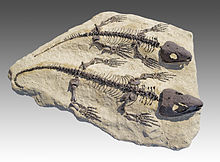大鼻龙科
| 大鼻龙科 | |
|---|---|

| |
| 大鼻龙 | |
无效状况
| |
| 科学分类 | |
| 界: | 动物界 Animalia |
| 门: | 脊索动物门 Chordata |
| 纲: | 爬行纲 Reptilia |
| 演化支: | 真爬行动物 Eureptilia |
| 科: | †大鼻龙科 Captorhinidae Case, 1911 |
| 异名 | |
| |
大鼻龙科(Captorhinidae)又译狭鼻龙科,别名杯龙类(Cotylosauria),是最早、最原始的爬行动物之一。其种类的体长从10几厘米到超过2米。
叙述
[编辑]
大鼻龙科是一群小型、类似蜥蜴的爬行动物,存活在晚石炭纪到二叠纪。
与它们的近亲原古蜥科相比,大鼻龙科的头颅骨还强壮,而牙齿更能处理较硬的植物。大鼻龙科的头骨宽广、粗壮、略呈三角形。前上颌骨往下弯。早期种类只有单排端生齿,而较衍化的物种(例如大鼻龙、Moradisaurus)具有多排齿和槽生齿。
大鼻龙科的身体骨骼,仍非常类似早期爬行形类(Reptiliomorph)。在20世纪早期的传统分类法,西蒙螈形类、阔齿龙形类、以及大鼻龙类,常被认为是最早期的爬行动物,都归类于杯龙目(Cotylosauria)。西蒙螈形类、阔齿龙形类目前都属于爬行形类的早期演化支[1]。
大鼻龙科的尾椎具有特殊裂纹,因此可能有逃生用的断尾技能,不过并没有表示其断尾之后具有弹跳动力;以及再生新尾巴的证据[2]。
发现与研究历史
[编辑]
早期研究认为Concordia是最原始的大鼻龙类动物。在2006年,一份早期爬行动物种系发生学研究发现图林根窗龙是大鼻龙科的姐妹分类单元。因此图林根窗龙是已知最基础、最原始的大鼻龙类[3]。之后其他研究也得出类似结果[4][5]。Concordia是唯一生存于石炭纪晚期的大鼻龙类,仍是生存时代最早的大鼻龙类[3]。
大鼻龙科之内有Moradisaurinae亚科。在1982年,A. D. Ricqlès、P. Taquet建立Moradisaurinae亚科,属于大鼻龙科。Moradisaurinae亚科的定义是:大鼻龙类之内,亲缘关系接近Moradisaurus,而离大鼻龙较远的所有物种。Moradisaurinae亚科的化石发现于中国、摩洛哥、尼日、俄罗斯、美国德州与奥克拉荷马州[4]。Moradisaurinae亚科被认为是植食性动物,或以昆虫为食[6]。
在Labidosaurus hamatus的下颌化石上,找到了已知最古老的蛀牙纪录[7]。
分类
[编辑]- 大鼻龙科 Captorhinidae
- 疑名
- Puercosaurus
- Riabininus
演化树
[编辑]| 大鼻龙科 |
| ||||||||||||||||||||||||||||||||||||||||||||||||||||||
以下演化树来自于2011年版本[4]:
| |||||||||||||||||||||||||||||||||||||||||||||||||||||||||||||||||||||||||||||||||||||||||||
参考资料
[编辑]- ^ Goodrich, E.S. On the classification of the Reptilia. Proceedings of the Royal Society of London. 1916, 89B: 261–276. doi:10.1098/rspb.1916.0012.
- ^ LeBlanc, A. R. H.; MacDougall, M. J.; Haridy, Y.; Scott, D.; Reisz, R. R. Caudal autotomy as anti-predatory behaviour in Palaeozoic reptiles. Scientific Reports. 2018-12, 8 (1): 3328 [2020-02-23]. ISSN 2045-2322. PMC 5838224
 . PMID 29507301. doi:10.1038/s41598-018-21526-3. (原始内容存档于2020-05-04) (英语).
. PMID 29507301. doi:10.1038/s41598-018-21526-3. (原始内容存档于2020-05-04) (英语).
- ^ 3.0 3.1 Muller, J. and Reisz, R.R. (2006). "The phylogeny of early eureptiles: Comparing parsimony and Bayesian approaches in the investigation of a basal fossil clade." Systematic Biology, 55(3):503-511. doi:10.1080/10635150600755396
- ^ 4.0 4.1 4.2 4.3 Robert R. Reisz, Jun Liu, Jin-Ling Li and Johannes Müller. A new captorhinid reptile, Gansurhinus qingtoushanensis, gen. et sp. nov., from the Permian of China. Naturwissenschaften. 2011, 98 (5): 435–441 [2012-04-08]. PMID 21484260. doi:10.1007/s00114-011-0793-0. (原始内容存档于2020-04-14).
- ^ 5.0 5.1 5.2 Sumida, S.S.; Dodick, J.; Metcalf, A.; Albright, G. Reiszorhinus olsoni, a new single-tooth-rowed captorhinid reptile of the Lower Permian of Texas. Journal of Vertebrate Paleontology. 2010, 30 (3): 704–714 [2012-04-08]. doi:10.1080/02724631003758078. (原始内容存档于2020-05-11).
- ^ 6.0 6.1 6.2 The Paleobiology Database: Moradisaurinae. [2012-04-08]. (原始内容存档于2011-10-04).
- ^ Reisz, Robert R.; Scott, Diane M.; Pynn, Bruce R.; Modesto, Sean P. Osteomyelitis in a Paleozoic reptile: ancient evidence for bacterial infection and its evolutionary significance. Naturwissenschaften. 2011-06, 98 (6): 551–555. ISSN 0028-1042. doi:10.1007/s00114-011-0792-1 (英语).
- ^ Nor-Eddine Jalil and Jean-Michel Dutuit. Permian captorhinid reptiles from the Argana formation, Morocco (PDF). Palaeontology. 1996, 39 (4): 907–918 [2012-04-08]. (原始内容 (PDF)存档于2012-04-25).
- ^ W. J. May and Richard L. Cifelli. Baeotherates fortsillensis, A New Captorhinid Reptile from the Fort Sill Fissures, Lower Permian of Oklahoma. Oklahoma Geology Notes. 1998, 58: 128–137.
外部链接
[编辑]- Captorhinidae Cladogram
- Concordia Cunninghami, the earliest example Captorhinidae.








